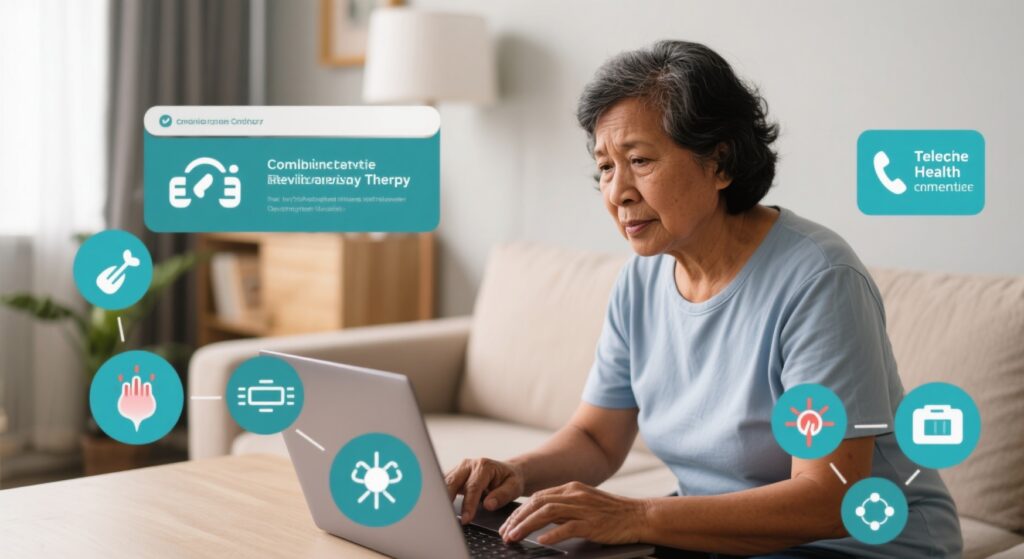Highlight
– Remote, scalable CBT-based interventions (telehealth and self-guided online programs) significantly improved pain and functional outcomes in high-impact chronic pain compared to usual care.
– The health coach–led telehealth intervention was more effective than the self-completed online program, but both outperformed usual care.
– These approaches offer a pragmatic solution to expand access to first-line, nonpharmacologic pain management, especially for rural or medically underserved populations.
Background
Chronic pain, particularly high-impact chronic pain that disrupts daily life, represents a major public health challenge in the United States. Affecting millions, it leads to disability, reduced quality of life, and substantial economic costs. Current guidelines recommend cognitive behavioral therapy (CBT)-based skills training as a first-line, nonpharmacologic treatment for chronic pain syndromes, including musculoskeletal conditions. However, access barriers—including limited numbers of trained therapists, geographic disparities, and logistical obstacles—have restricted the widespread adoption of CBT for chronic pain, especially in rural and underserved communities.
Study Overview and Methodological Design
DeBar et al. (2025) addressed this evidence gap by conducting a large, pragmatic, phase 3 randomized clinical trial (RCT) to evaluate remote, scalable CBT-based interventions for high-impact chronic musculoskeletal pain. The trial enrolled 2,331 adults (mean age, 58.8 years; 74% women; 44% rural/medically underserved) from four diverse U.S. healthcare systems between January 2021 and February 2023. Participants met criteria for high-impact chronic musculoskeletal pain and were randomized in a 1:1:1 ratio to one of three groups:
1. Health coach–led CBT-CP via telephone/videoconferencing (n=778)
2. Self-completed online program (painTRAINER; n=776)
3. Usual care plus a pain resource guide (n=777)
Both interventions consisted of 8 sessions, with the primary endpoint being the proportion of participants achieving a ≥30% reduction in pain severity (the minimal clinically important difference, MCID) on the Brief Pain Inventory–Short Form at 3 months. Secondary endpoints included pain intensity, pain-related interference, social role and physical functioning (PROMIS), and patient global impression of change, evaluated at 3, 6, and 12 months.
Key Findings
The trial demonstrated that both remote CBT-CP interventions significantly outperformed usual care in achieving clinically meaningful pain reduction at 3 months:
– Health coach group: 32.0% (95% CI, 29.3–35.0) achieved ≥30% pain reduction
– painTRAINER group: 26.6% (95% CI, 23.4–30.2)
– Usual care: 20.8% (95% CI, 18.0–24.0)
Relative risk (RR) comparisons:
– Health coach vs. usual care: RR 1.54 (95% CI, 1.30–1.82)
– painTRAINER vs. usual care: RR 1.28 (95% CI, 1.06–1.55)
– Health coach vs. painTRAINER: RR 1.20 (95% CI, 1.03–1.40)
Statistically significant improvements favoring both intervention arms were sustained at 6 and 12 months for pain severity, as well as for secondary outcomes related to function and quality of life.
Mechanistic Insights and Pathophysiological Context
CBT for chronic pain seeks to modify maladaptive thoughts, emotions, and behaviors linked to pain perception and disability. Mechanistically, CBT reduces pain catastrophizing, enhances coping strategies, and supports behavioral activation—factors known to mediate pain severity and interference. Telehealth and online delivery platforms preserve these mechanisms by providing structured skills training and cognitive reframing, even in the absence of face-to-face interaction. The added benefit of health coach guidance may stem from increased accountability, motivational support, and individualized feedback, reinforcing behavior change and skill acquisition.
Clinical Implications
This study provides robust, generalizable evidence that remote CBT-CP interventions can be effectively integrated into routine care for high-impact chronic pain, especially where in-person CBT is inaccessible. Both telehealth and self-guided online programs offer scalable, lower-resource alternatives to traditional therapy, with the health coach–led model conferring the greatest benefit. These interventions are particularly valuable for rural or underserved populations, a major strength of this trial’s diverse sample. For clinicians, remote CBT-CP can be recommended as a first-line adjunct or alternative to pharmacologic therapy, supporting the shift toward nonopioid pain management strategies.
Limitations and Controversies
The observed improvements, while statistically significant, were modest, with only about one-third of participants in the most effective arm achieving a clinically meaningful reduction in pain. Engagement and adherence in digital interventions remain challenging, and the generalizability to non-English speakers or populations with limited digital literacy is uncertain. The study did not directly compare remote interventions to in-person CBT, leaving open questions about comparative efficacy. Additionally, resource constraints in real-world settings may limit the scalability of health coach–led programs relative to fully automated modules.
Expert Commentary or Guideline Positioning
Current guidelines from organizations such as the CDC and American College of Physicians endorse CBT as a core component of chronic pain management. This trial underscores the feasibility and effectiveness of remote delivery, aligning with calls to expand digital behavioral health infrastructure. As Dr. Erin Krebs, a leading pain researcher, has noted in commentary on similar trials, “Bringing evidence-based pain treatments closer to patients’ homes is a critical step in reducing disparities and improving outcomes.”
Conclusion
Remote, scalable CBT-based interventions—delivered via telehealth or online programs—provide a modest but meaningful improvement in pain and function for individuals with high-impact chronic pain. These approaches can substantially expand access to guideline-recommended, nonpharmacologic pain management, particularly for underserved populations. Future research should address strategies to enhance engagement, evaluate cost-effectiveness, and compare remote vs. in-person modalities to optimize chronic pain care.
References
1. DeBar LL, Mayhew M, Wellman RD, et al. Telehealth and Online Cognitive Behavioral Therapy-Based Treatments for High-Impact Chronic Pain: A Randomized Clinical Trial. JAMA. 2025 Jul 23:e2511178. doi: 10.1001/jama.2025.11178. Epub ahead of print. PMID: 40699570; PMCID: PMC12287937.
2. Dowell D, Haegerich TM, Chou R. CDC Guideline for Prescribing Opioids for Chronic Pain—United States, 2016. JAMA. 2016;315(15):1624-1645.
3. Qaseem A, Wilt TJ, McLean RM, et al. Noninvasive Treatments for Acute, Subacute, and Chronic Low Back Pain: A Clinical Practice Guideline from the American College of Physicians. Ann Intern Med. 2017;166(7):514-530.



